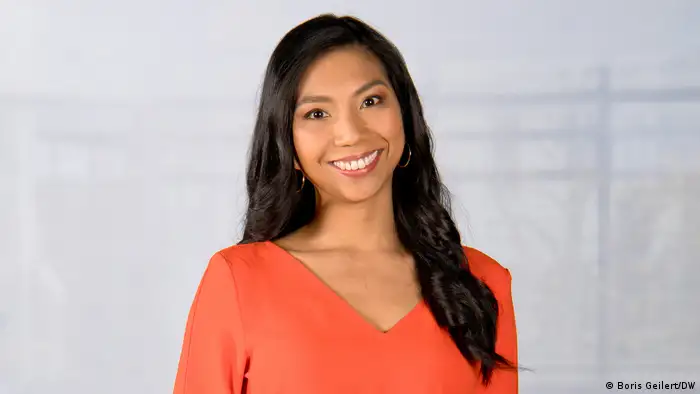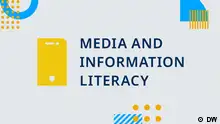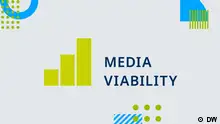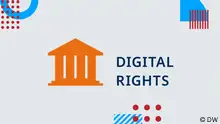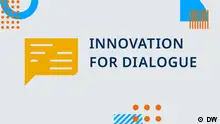Podcast
Michelle Nogales of Muy Waso, Bolivia: How to survive and thrive as a feminist media outlet | The Media Viability Podcast S02E03 transcript
Our 2024 Women’s Month episode of "Survive and Thrive: The Media Viability Podcast" couldn’t feature a more suitable guest: Michelle Nogales is the CEO of Muy Waso, Bolivia’s first feminist online magazine.
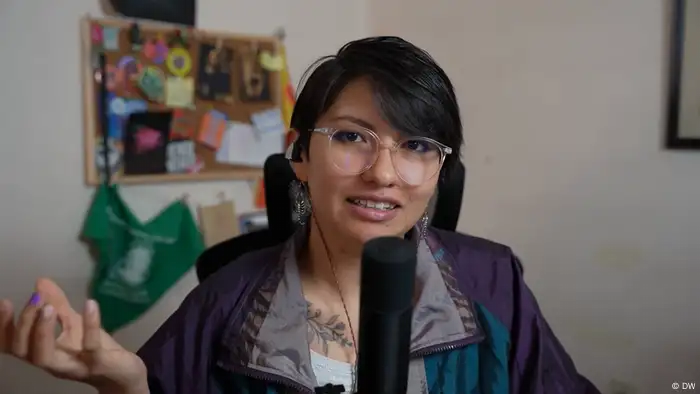
Michelle Nogales, CEO of Muy Waso, Bolivias first feminist online magazine, during the recording of DW Akademie's "Survive and Thrive: The Media Viability Podcast"
Welcome to "Survive and Thrive," DW Akademie’s dialogue with media managers on innovative and sustainable business models in a challenging global media landscape. We'll talk motivation, lessons learned, funding models, best practices, recipes for success and decisions – both good and bad.
Watch here, or read the complete transcript below
Janelle Dumalaon (host): Welcome to Survive and Thrive, your media viability podcast. The mission we have, as usual, is to talk about the challenges involved in getting our media outlets to do just that: Survive and thrive.
It is getting ever harder to fulfill the promise of journalism, to provide free and fair information and ensure and inform citizenry. As challenges abound, from keeping up with technological changes, creating reporting of value in a crowded media environment and financing challenges, there's no shortage of threats to viability for media organizations.
As such, there's a need for media producers to learn from each other, to ask how we're all adapting to the world we live in. Today, we're hearing from Michelle Nogales, CEO of Muy Waso in Bolivia. Welcome, Michelle.
Michelle Nogales: Thank you, Janelle. Thanks for having me.
Dumalaon: We'll hear about what it means to run Muy Waso. But first, this quick questionnaire: Your business model in a catch phrase.
Nogales: I think our business model is chameleonic because we adapt to the circumstances and we transform to the environment or the situation. We transform to survive.
Shape shifting as needed. Second question: Did you ever manage a moment when everything seemed lost?
Yeah, I think that was right away after the emergency of the COVID-19 pandemic because that was the moment when we were thinking "Oh my God, there is no more funding that is helping media." Due to the pandemic, we really needed to figure out what we were going to do, and how. And we really had to be clear about the future of Muy Waso. But the situation was very hard. We were struggling about how to do it, we needed to think about strategies and put in a lot of hard work. It was it was quite difficult. I think that was the hardest moment for Muy Waso.
Money problems are a recurring theme. Third question: What would you need to thrive in the future?
Well, something that we’ve been thinking about for Muy Waso is the ability to manage – you know – management skills. Having knowledge about human resources, about how to lead our team – because that’s something that we have been struggling with the last years. We’ve found it hard to find people, to find talent that shares the same values and has the same commitment to communication and journalism that we have.
So, I think we need to get better our abilities to find, identify, hire and keep talented people in Muy Waso.
So, to improve at meeting human resources challenges, if I understand correctly. Once again, we’re talking about Muy Waso, a feminist magazine focused on culture in Bolivia. Michelle, for our non-Spanish speaking listeners out there, what does Muy Waso mean and why did you decide to name your outlet that?
That’s a very frequently asked question. Everybody's like, what is Muy Waso? What does it mean? Even in Spanish, because Muy Waso is slang from the more indigenous side of Bolivian society and it’s very popular among young people, meaning "that's rebel, that's irreverent, that's crazy."
It’s something your mom would say if you behave badly, "you are being muy waso."
We chose this name because we wanted to do things differently from how they were being done in the Bolivian journalism environment until then. We wanted to break down all those manners, all those ways to be, and that is where it comes from.
With a name like Muy Waso, you're clearly looking to shake things up, so to speak. Why was it important for you to create a magazine with that kind of identity – a feminist magazine in Bolivia?
Well, we actually first felt this need in ourselves. Mijail Miranda and I – we are the co-founders – we have been ourselves in need of this kind of information, needing information that has a feminist perspective. We were seeking for it. We were trying to read something that had this approach and we couldn't find it.
So, we decided: If someone has to do it, let it be us!
And we also saw that there were a lot of things, a lot of diversity, so many aspects about culture, women’s work, the way women are viewed, LGBTQ+ people that weren’t being said on traditional media. All this seemed rich to us, beautiful, amazing. So, we said: "OK, we need to relate this to our public, take this to other Bolivian people so they, too, can see all this stuff and can get to know the Bolivian cultural reality from another perspective." That’s how Muy Waso was born.
Now, of course, there's the idea side of things and there's also the operation side of things. Can you tell us a little bit more about your business model and what it means to operate a feminist magazine in Bolivia?
Sure. When we started with this initiative, we knew that we wanted to make cultural content from a feminist perspective. We also viewed journalism as a service we’re giving to people. That’s why we wanted to keep it free, open, available to everyone – not only to people who have regular internet access, or who are on some social media platforms. We want to keep it open for everyone and that’s still one of our biggest struggles.
How can we reach people that cannot be connected to the Internet most of the time or that only have really bad connection? How can we make our website lighter so that it loads fast? How can we even make things easier for people who don’t have access to the Internet?
That’s our main motivation.
So, we realized we need to keep the project going in a way where we don't have to ask people to pay for the journalism we do. But we also need to work toward people recognizing that this is a job, it is effort and there are people behind it.
As you can imagine, building this business model is the hardest part. So, we started to receive donations. We have something that is called the Muy Waso piggy here in Bolivia. People save money in piggy banks here, saving away their coins, and we adapted this concept for Muy Waso: A piggy bank where you can leave donations for us. That was our first approach to a business model.
And then we started to apply for grants. Actually, with the pandemic, we saw a few calls for grant applications about journalism and decided to go for it. At the beginning, we had like about 70% of our income from grants and other fellowships and just a little bit from donations.
And then we saw that these grants were going away – that was what I spoke about before – after the emergency of the pandemic. So, we started thinking about how we could sustain this, how we could keep it afloat. That was the moment when we saw that the work we did – the communication, the strategy, the journalistic work that we were making – it was a bit different and it was attractive.
So, we started offering these services to other organizations that share our values, like NGOs, organizations that work with – for example – climate change, women and kids. Everything that is aligned to our values.
You can say that Muy Waso as an agency started to work when we offered these communication services to others and they paid us for it. That helps us to maintain and sustain the journalistic work that we are doing. Even though that means that we have to work a lot more and we have to put a lot more effort into it, but this guarantees that all these people, our communities, have access to quality information.
Well, that's a that's a really interesting description of how you've decided to fund your publication.
So, if I understand correctly, what you do is that you leverage the skill set that you have and you offer it to other organizations and provide communication services to them and that in turn helps to fund the journalistic work.
I guess my question is: In this world of limited resources, I imagine you have a smaller team, and there are only so many hours in a day. So, how do you manage to maintain Muy Waso’s identity foremost as a journalistic outlet and not as a communications agency, even though it is in a very important part of your operations?
Well, actually, we find a pivoting way to work in some of the of the products that we offer to other organizations. Let's say somebody wants an investigative article or an investigation about the situation of the water in some community. They’re willing to pay for this job but want it published on Muy Waso.
From our founding until 2021/ 2022, we built a very strong institution around our media outlet. And we have been massive, the content we create is very attractive, we were exploring and working with some innovative formats. And other people have been seeing this and saying, "Oh my God, I like it! I want my article to be there."
And when someone pays for an article or wants to work together on producing an article that will be published on Muy Waso, we say OK. That’s content for the media. They pay for the work, for the journalistic piece and it also goes on our media outlet. We’re trying all the time to make the most from the work that we invest a lot of human resources, money and time into.
And we also have two initiatives that have their own funding. One is the first national prize for feminist journalism where we give money to young people, LGBTQ+ people and especially women to produce a journalistic piece. People send in their proposals, we choose three and give them the money to produce their pieces, as well as workshops and an editorial support. So, through this process they produce the pieces along with us, our editorial team, and this also gives us material, articles, investigations that are really solid and big and have different perspectives from all the parts of this very diverse country.
These are two of the ways that we feed our journalistic project. Another one is funding for shorter journalistic pieces. People can send in a proposal and we have a cooperation. It’s not a big editorial partnership but the production is done with our editorial team.
So, we have these two ways to generate material for our media outlet. And we are all the time producing smaller things, like for our TikTok channel where we are publishing videos about feminist perspective, culture, the environment, health. We’re not only focused on writing, on texts. We also have podcasts, videos, infographics, images.
We’re active all the time, we’re working all the time, so that Muy Waso is always on the beat, present and in our community’s minds.
So, for example, you were to partner with an NGO, say a climate NGO, an NGO that specializes in the impact of climate on women. What they would do is work with you together to produce an article that ends up on Muy Waso.
Yes, most of the organizations want the piece to be published in Muy Waso. It would then clearly say on the publication that this was in collaboration with this and that NGO. It would make clear the context and who has the editorial oversight, because this is quite a specific structure, of course.
And who at the end of the day makes the editorial decisions of whether this is the best piece of journalistic output for your users?
Actually the whole editorial decision lies with us. In the beginning we always say, we’ll give you a proposal. You give us a topic and we'll give you the proposal or you give us a topic and the data.
Sometimes the organizations have a lot of resources to build a good journalistic piece and can provide us with resources like data, photography even, people who we can interview, the contacts. But the approach, the way that we build the piece, the article, that comes from us and we have a process by which we coordinate with the organization.
So, we say, OK, we're having this approach, we're having this protagonist in the story. What do you think? They say, OK, it's great.
It’s a process. The whole editorial decision goes through Muy Waso and the organization usually only gives a few moments of feedback where we can adjust some things, but the main structure is made by us.
Now if you had to describe Muy Waso to somebody based on an example of your work, what would you choose?
I think I would choose a TikTok video. We have one about gynecological violence. It explores how women can be safer at a gynecological appointment. We give all the information about gynecological violence, about the laws and what people can do in a case of abuse.
The video starts with "here’s some advice for your next gynecological appointment," and then I start speaking and it's very dynamic and it's young and the language is so easy.
This piece represents a lot: Simple language, high quality information, entertaining and dynamic – and also innovative.
Clearly, you've noticed that there is a need for these sorts of informational videos and content that discuss issues affecting women. How are these topics usually treated in Bolivian society?
Well, most of these feminist topics are related to women's health, women’s rights, maternity. Everything that has to do with women’s sexuality is really a taboo here, because Bolivia is a very macho society. The patriarchy is strong in Boliva, like in a lot of other Latin American countries, and there are so many things that are actually crucial for women’s lives that aren't discussed, that people and the media don’t talk about.
We don't have research, we don't have data, we don't have access to this information. Or there might be information, but it's in a language super technical and hard to understand. So, that is something that we are committed to: Giving women and LGBTQ+ people access to this vital information. And there are also people from the rural areas, indigenous people who need to have access to this or other information that aren't able to reach it.
That’s what we are committed to. And what we are fighting with a lot are all these ideas of how women should behave. All these concepts people have about women's bodies and women's activities, it’s a constant fight.
And we do have times where we receive a higher amount of reactions, violence, insults but there also are lower times. The violence ebbs and flows. It’s a bit like riding a boat, you know, in a big sea. We have to manage it and deal with it. And, actually, we have seen some progress, we have seen some changes, but there is a lot more to do.
This is what we keep pointing toward. We keep on changing things because we believe that communication and journalism is for change, it is for transformation.
You were talking about how trying to deal with these issues, trying to address them, is a bit like being a small boat in a big sea. I took that to mean there's a lot going on at the same time, there are a lot of challenges to weather.
What sort of impact would you say you've had on viewers and users? Do you get the sort of feedback where they say, listen, I learned so much from this, from this and that article, from this and that video. Could you do more of the same?
What sort of interaction do you have with your audience?
Our audience, our community gives us so much love that sometimes I'm overwhelmed by it.
We always have open channels to interact with them: On Instagram, WhatsApp, Facebook or TikTok. And when we provide some information, people are always thankful. They’re always like, "Oh, I didn't know this. I will use it next time. Thank you for sharing this." Or, "Could you please do more coverage about this topic or maybe could you cover this this theme more specifically?"
They are always asking for more or asking to do something again. But them always being like "please do more, please do more," that thankfulness also comes with frustration, because we do want to do more. We want to give you more, we want to change more things for you.
The first moment we experienced this was with COVID. People reached out to us to say thank you or say that no other media outlet was doing what we did. They thanked us for the information.
And when it comes to feminism, or the rights of LGBTQ+ people, even showing our audience that LGBTQ+ people exist – they are very thankful to be the protagonist of the stories. People who write stories for us are super thankful for having the space. We care about having diversity among our authors and protagonists.
So, I think we have a really beautiful community that appreciates what we do and they always support us. Even if it’s not with money, they support us with what they can.
That must be that must be very satisfying, as a producer of media, to know that the people you are talking about feel represented in your stories and that you are addressing the things that most concern them. And then they feel seen, their stories are highlighted and visible because of you, because of your role in the media landscape.
Of course, Bolivia also has a lot of legacy media, a lot of institutional media. What is the media landscape in Bolivia like more generally?
The media landscape in Bolivia was quite traditional. There were just a few attempts by digital media outlets, and there were no feminist media outlets. We were the first ones.
I think, since the pandemic, the landscape has been transformed. Before the pandemic, traditional media outlets were the biggest fish in the ocean and the pandemic changed everything. There are now new ways to address journalism.
With the internet and the digital world coming to Bolivia, it changed everything. We now have very weak traditional media outlets that depend a lot on government money and if they don’t share the political view or their editorial line with the government, then the government would cut their funds.
And the other source of money are different private companies. If you don't have anything to do with them, if you don't have friends there or done business with them before, they won't give you money. Because of that, traditional media are struggling with that and with adapting to the new ways to do journalism and all these threats that are coming, like AI and the ways people consume information.
We just saw one big media outlet close – a newspaper. It stopped functioning last year.
And digital media outlets started popping up, because when big media outlets close, these journalists need a job and start their own media initiatives and websites. We’ve seen a lot of small digital, native digital media, but they’re hard to sustain. As the years go by, many of them end up closing or reducing from a big team to two people.
It is quite hard and within this global media apocalypse we’re living in, it’s even harder.
We have the algorithms from Google changing all the time and as a result, our websites aren’t seen as they were a few years ago. AI are producing shorter versions of your website content, which keeps people from visiting it. It's a really dark future, I think.
But as I said when talking about the business model: We have to be like a chameleon. We have to adapt, we have to see how we can transform and how we can survive by changing things or stopping to do some other things.
It’s a bad time for media outlets in Bolivia. But I think there is a lot of creative and smart people, and we are used to fighting. Our social history made us into fighters, so I think we are going to fight it until we cannot anymore.
This phrase that you mentioned here, the global media apocalypse, it's certainly an appropriate phrase. That is certainly something that is happening.
There's a lot of threats to the global media landscape at the moment and it's just very interesting to see how in many different countries around the world this fight is being taken up differently. And I would like to thank you for sharing your hope and your optimism and your belief in the struggle to save journalism.
Earlier you talked about the challenges of managing a team, that you're learning what it means to have business operations, to get the most out of your people and to allocate resources.
What is the best lesson that you learned from your efforts to better understand how this works?
Well, there are things that I've learned about managing a team. Most of the people that start media outlets are journalists and only know how to be a journalist.
We actually don't know how to manage people. We don't know how to have a media outlet. We don't know anything about cooperative stuff or about being an entrepreneur. There’s a lot of things that we don't know and the media management I think is the hardest.
The best thing to do is join some spaces, join people, join organizations that will give you advice about this.
I have been learning everything that I know because of some courses and fellowships, and they have made me stronger. All that I know right now is because of that and because of the experience and because of having made many mistakes.
When you are a journalist, you think that you will only have to write an article, know how to take a picture and upload your content to the website. But actually, you need a lot more.
And the most important thing that we learned in the process is to trust our instincts, trust in what we believe. Never betray your beliefs. That's the most important thing. Because as I said at the beginning, communication and journalism are a service to people. Communication and journalism can transform reality, can change our society.
If you want to be rich, become a billionaire, communications is not the right place. You know you are not in the right place because it's not ethical. Communication should be free for people. People should always have access to high quality information. That’s vital.
That's something you should always have in mind when you are working in journalism and the media: You are working for the people.
So, if you never betray what you believe, if you never betray your commitment, your values, you're going to do well.
And we always prioritize the existence of the media outlet. We said: OK, if we don't have a big salary, it doesn't matter. We need to guarantee that the media outlets will keep existing, will keep on going. We'll have a regular or even lower than regular salary. But the media it's still there, you can still have access to it. That's something very important because people usually receive a grant and they invest everything and they have like eight journalists, photographers and one graphic designer and all the money just flies away.
But if you have this instinct, this commitment, you will say: OK, we will just manage to use the money drop by drop so it can last longer and we can guarantee that the media will keep existing.
If you have this in your mind, you can deal with anything. You can say: OK, we can do this. We need to, I don't know, make this money last for six months and in this six months we need to find three other clients so we can last another three months.
And you keep on going like that, always having your mind with the priorities. The most important thing is to keep your media outlet going. And to stay true to your values.
Before we let you go, can you name three best practices for us that you learned in your time running Muy Waso?
I talked about this with my friend, colleague and partner Mikhail. The first one is to always learn. Keep on learning everything that you can, not only about journalism but about management, about video, images, podcasts – everything will be useful for you. You have to keep on doing it because the world keeps on changing – and fast.
Go to courses, take classes, participate in fellowships – anything that you can.
The second advice is to have patience, because it's a long process. It’s like a slow-cooking process. Sometimes you won't have the views that you were hoping for, you won't have the impact that you were hoping for. But this will take its own time, so you have to be patient.
You have to never give up because it's a process that sometimes could be really exhausting and overwhelming. But in the end, there’ll be the reward of people having information that will change their lives, or that will at least make them happier one day, or will give them solution to a specific problem. That's the biggest reward.
And the third one is: Never aim to grow bigger and faster. Don't go after that. This is not The Fast and the Furious. If your media outlet has two people at the beginning, just try to make the process between them perfect and then you can add a third person.
If with three people it works out, improve the process and then you can add a fourth and a fifth. You’ll have to grow slowly and you’ll have to have all the internal processes really solid, really well done. If you grow like crazy, things will blow up and things won’t work.
That’s what happened to us with a grant: We had money to hire people and we went from three to eight or ten people and couldn’t manage. It was a waste of money and of time. It was so overwhelming. We ended up burnt out because we didn't know how to deal with the process for nine or ten people.
Alright, let's see if I got this: Learn at all times! Go to classes, fellowships, lectures that will teach you ever more about the practice of journalism. Have patience because results take time. And, finally, grow at your own pace.
Yes.
Thank you very much to our guest today, Michelle Nogales of Muy Waso in Bolivia. We appreciated all of your insights today and once again your optimism and your hope for the future. It's something that we should all carry with us as we try to do our best in this ever-changing world.
Thanks for having me, Janelle.
This transcript of "Survive and Thrive: The Media Viability Podcast" has been lightly edited for clarity.
Get in touch
For questions and suggestions write to dw-akademie.surviveandthrive@dw.com
Or find us on Twitter, Facebook, LinkedIn and Youtube.
This podcast is produced by DW Akademie and is supported by the Federal Ministry for Economic Cooperation and Development (BMZ).
DW recommends
Previous episodes
- Date 30.03.2024
- Keywords DW Akademie, survive and thrive, podcast, media viability, business, Media Management, media freedom, quality media, journalism, feminism, women, Bolivia, Muy Waso, business model, revenue, Pluralism, freedom of speech
- Feedback: Send us your feedback.
- Print Print this page
- Permalink https://p.dw.com/p/4eAF2
- Date 30.03.2024
- Keywords DW Akademie, survive and thrive, podcast, media viability, business, Media Management, media freedom, quality media, journalism, feminism, women, Bolivia, Muy Waso, business model, revenue, Pluralism, freedom of speech
- Send us your feedback.
- Print Print this page
- Permalink https://p.dw.com/p/4eAF2

